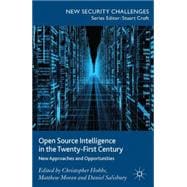Drawing on a diverse range of experience and expertise, the book begins with a number of chapters devoted to exploring the uses and value of OSINT in a general sense, identifying patterns, trends and key areas of debate. The focus of the book then turns to the role and influence of OSINT in three key areas of international security – nuclear proliferation; humanitarian crises; and terrorism. The book offers a timely discussion on the merits and failings of OSINT and provides readers with an insight into the latest and most original research being conducted in this area.









